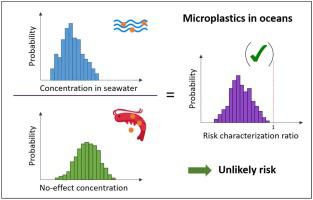Aquatic Toxicology ( IF 4.5 ) Pub Date : 2020-11-25 , DOI: 10.1016/j.aquatox.2020.105689 Véronique Adam , Alex von Wyl , Bernd Nowack

|
Microplastics are ubiquitous in the environment and given the large number of published hazard and exposure studies, quantitative environmental risks assessments of microplastics become feasible. We present here the first environmental risk assessment for marine waters based only on measured concentrations. The Thevariability and uncertainty of the measured data was accounted for in the exposure assessment, while probabilistic species sensitivity distributions were used for hazard assessment, from which a probability distribution was extracted for the predicted no-effect concentration (PNEC). By dividing the exposure distribution by the PNEC-distribution, we were able to calculate probabilistic risk characterisation ratios for each water body in which measurements were performed. Results show a good coverage of the world's major water bodies by measured exposure concentrations (MECs), while the hazard assessment could be improved by aligning the type of particles tested in hazard studies (size, form, polymer) to those actually found in the oceans. Overall, the mean predicted no-effect concentration (PNEC) is 3.84·106 part m−3, with Oryzias melastigma being the most sensitive species (calculated mean NOEC of 3.90·106 part m−3). Interestingly, the only type of dose descriptor that could be extracted from the literature for particles above 10−20 μm was the highest observed no effect concentration (HONEC), which indicates a very low or null toxicity of these larger MPs towards marine organisms. The mean MEC is 1.5·103 part m−3, the highest concentrations being measured in the Atlantic and Pacific Ocean. Although there is a very small overlap of the probability distribution associated with the RCR (0.00002 % of the data points), the mean RCR is 4·10-4 and therefore risks are unlikely given the available data. However, as increasing amounts of plastic reach the environment, RCRs can be expected to increase in the future.
中文翻译:

海洋生境中微塑料的概率环境风险评估
微塑料在环境中无处不在,鉴于大量已公开的危害和暴露研究,对微塑料进行定量的环境风险评估变得可行。我们在此仅根据测得的浓度进行首次海水环境风险评估。在暴露评估中考虑了测量数据的可变性和不确定性,而概率物种敏感度分布用于危害评估,从中提取了预测的无效应浓度(PNEC)的概率分布。通过将暴露分布除以PNEC分布,我们能够计算出进行测量的每个水体的概率风险表征率。结果表明,该产品覆盖了全世界 通过测量暴露浓度(MEC)来确定主要水体,同时可以通过将危害研究中测试的颗粒类型(大小,形式,聚合物)与海洋中实际发现的颗粒类型相匹配来改善危害评估。总体而言,平均预期无效应浓度(PNEC)为3.84·106份m -3,其中最敏感的物种为Oryzias melastigma(计算得出的平均NOEC为3.90·10 6份m -3)。有趣的是,可以从文献中针对10-20μm以上的颗粒提取的剂量描述符的唯一类型是最高的无效应浓度(HONEC),这表明这些较大的MP对海洋生物的毒性非常低或为零。平均MEC为1.5·10 3份m -3,最高浓度在大西洋和太平洋中测得。尽管与RCR相关的概率分布有很小的重叠(0.00002%的数据点),但平均RCR为4·10 -4因此,根据现有数据,风险不太可能出现。但是,随着越来越多的塑料到达环境中,RCR有望在未来增加。

























 京公网安备 11010802027423号
京公网安备 11010802027423号